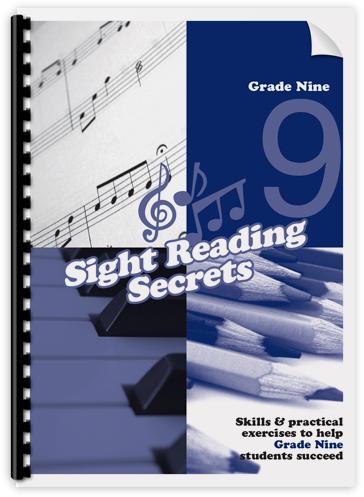Guest Podcast Appearance
Hear Bec in conversation with Tim Topham about the essential skill of sight reading music on Topcast Episode 317.
Sight Reading Secrets for Teachers
The number of students that don’t observe the key signature just amazes me! They keep ignoring the key signature, and wince every time they play a B instead of a Bb, but keep making the same mistake again and again. They need to get a sense of the key.
Students need to establish and maintain a steady pace; not necessarily fast, but steady.
Often there is an inability to read a rhythm, and the notes tumble out one after the other; the rests just get ignored!
The very highest level of sight playing is not only getting the notation correct, but also the rhythm, articulation, phrasing and expression. Every now and then you see a student who can do that, but it’s very rare. That’s the student who gets an A+.
– Peter Hurley, AMEB Examiner
How To Spend Less Time on Sight Reading and Get Better Exam Results
As a teacher myself, I know that the last thing you want to be doing a couple of weeks out from a student’s exam is desperately cramming sight reading. While your time could be better spent refining the expression of their repertoire, you spend stressful lessons tediously going over sight reading examples with your struggling student. Your students come to you to learn music, and your passion - what you actually get paid to do - is pass on your knowledge of technique, expression, and love of music. In contrast, sight reading is best learned by experience, which can happen through daily practice. A student will make little progress in their sight reading by only playing one or two examples in the last few weeks before their exam.
Make Your Lessons More Effective
Sight Reading Secrets is a curriculum to help your students develop sight reading skills with regular practice over the entire period they are preparing for an exam. The books allow a student to easily practice half an hour of sight reading each week – five minutes each day - at home. Then when you work on sight reading with them in your lesson, you can quickly assess where your student’s sight reading level has improved to, and identify which areas they are finding challenging. The student gets the maximum benefit from your teaching and you avoid spending hours teaching something they should be improving every day.
Better Exam Marks
My most frustrating exam reports have said “your sight reading cost you a grade today,” or “Sight Reading: poor” or even “Sight Reading: key sig?” Your students have worked hard, and their parents have invested a significant amount of money; you want the students to earn the highest mark they can and feel rewarded for their efforts. The confidence boost that your students get from being thoroughly prepared for every area of the exam is priceless. Sight Reading Secrets assists you in thoroughly preparing that motivated child. It helps parents have another way to support their child’s preparation, ensuring they can’t complain that their child can’t read music or that you didn’t prepare the student thoroughly. The student will know they did their best and the exam report will be a reward, not a let-down. The parents will be proud and pleased.
Method
- GRADED: a sight reading syllabus in small steps for each grade, taking your students step by step from sight reading of one grade level to the next.
- PRACTICE: a sight reading book with over 35 pages of examples for each grade, with many examples to reinforce each new sight reading concept.
- PEDAGOGY: a sight reading method that teaches students to understand what they read, so they recognize patterns and key elements instinctively, the same way a teacher reads music.
Introducing the Books
Book One: Preliminary / Grade One
Students will confirm essential reading skills like note values, rests and recognizing patterns of notes. Students will become confident in familiar hand positions as they are repeated, and will work out where to place their hands.
Preliminary examples are one stave only, using crotchets and minims, without key signatures. Grade One examples introduce two staves but with alternating hands, and systematically work through four major keys: C, G, D and F. The book concludes with examples featuring quavers.
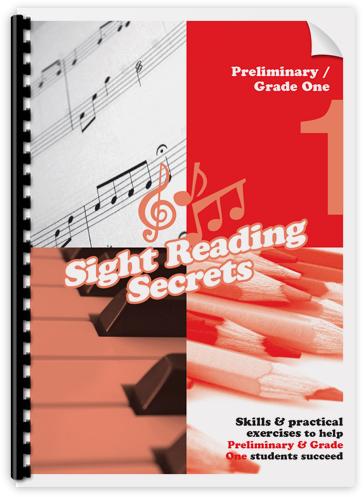
Book One: Preliminary / Grade One (ABC / Do Re Mi Edition)
Students will confirm essential reading skills like note values, rests and recognizing patterns of notes. Students will become confident in familiar hand positions as they are repeated, and will work out where to place their hands.
Preliminary examples are one stave only, using crotchets and minims, without key signatures. Grade One examples introduce two staves but with alternating hands, and systematically work through four major keys: C, G, D and F. The book concludes with examples featuring quavers.
Sight Reading Secrets Book One ABC/Do Re Mi edition is identical to Sight Reading Secrets Book One but with notes labelled in both solfege and alphabet. If your child does not use solfege (do re mi), we recommend the original edition - Sight Reading Secrets Book One.
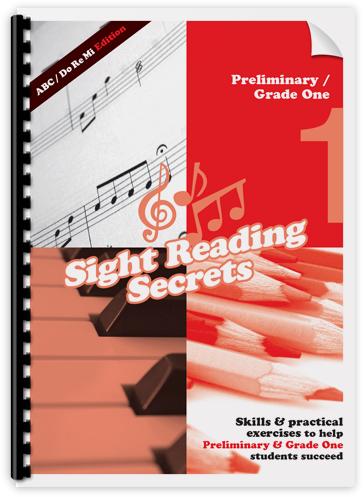
To help students learn to “think” in each key, and to include the sharps and flats as an integral part of the piece, there are several pages to work through for each key signature. Students will systematically experience the major and minor key belonging to each key signature required for Grade Two.
To help students play with continuity, there are many examples to work on alternating hands without a rest between the phrases, moving hand positions and stretching beyond a five-finger position.
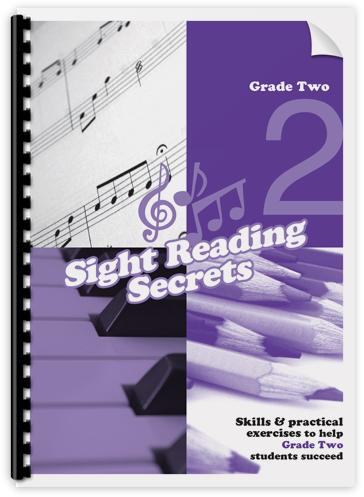
As for Sight Reading Secrets Book Two, students are encouraged to “think” in each key, and to include the sharps and flats as an integral part of the piece, with several pages to work through for each key signature. Students will systematically experience the major and minor key belonging to each key signature required for sight reading in Grade Three. These examples are for hands together sight reading.
To help students play with continuity, the sight reading examples become more complex in hands together co-ordination, starting with semibreves in one hand, then examples with one hand moving faster than the other, and so on. There are chapters to help students increase their sight reading skills in simple triple meter, ties and chords.
To help students play expressively, the sight reading pieces become more complex as the book progresses, gradually introducing articulation, dynamics and tempo markings.
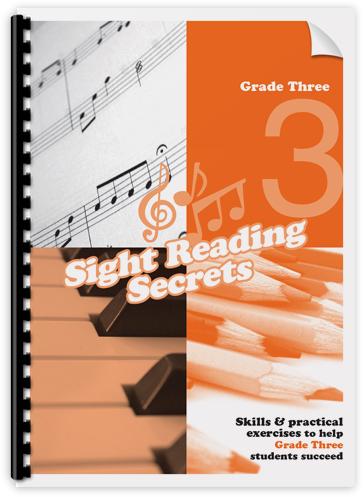
Continuing the key signature pedagogy of Sight Reading Secrets Books Two and Three, several pages in a row are dedicated to one key signature. In addition, several famous folk tunes are included in five keys, so students are able to hear the sound of each particular key and confirm their awareness of the necessary sharps or flats.
To help students play expressively, a wide variety of articulation, dynamics and tempo markings are included throughout the book.
The book has chapters dedicated to 6/8 time and to the dotted quaver / semiquaver pattern to help students feel more confident when sight reading in their Grade Four exam.
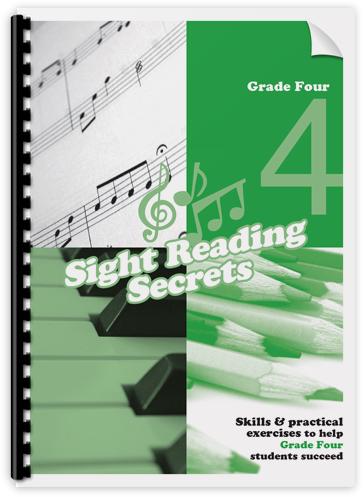
This is a written activity book which confirms note names in treble and bass so students can increase their response time and accuracy when sight reading. Students write the names of the notes, or to draw notes corresponding to the letter names as directed.
Students will memorize a group of notes by working on the same group of notes on several pages in a row: Treble Clef Spaces, Treble Clef Lines, Treble Clef Notes, Bass Clef Spaces, Bass Clef Lines, Bass Clef Notes, Treble Clef Leger Lines, Bass Clef Leger Lines.
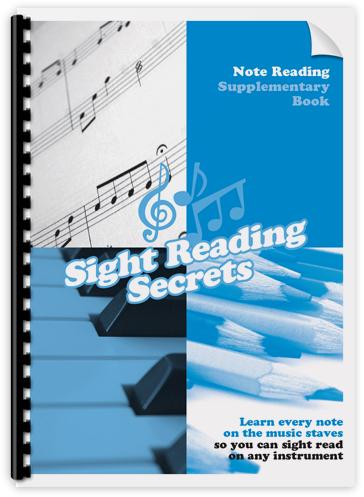
Note Reading Secrets (ABC / Do Re Mi Edition)
This is a written activity book which confirms note names in treble and bass so students can increase their response time and accuracy when sight reading. Students write the names of the notes, or to draw notes corresponding to the letter names as directed.
Students will memorize a group of notes by working on the same group of notes on several pages in a row: Treble Clef Spaces, Treble Clef Lines, Treble Clef Notes, Bass Clef Spaces, Bass Clef Lines, Bass Clef Notes, Treble Clef Leger Lines, Bass Clef Leger Lines.
Note Reading Secrets ABC/Do Re Mi edition is identical to Note Reading Secrets but with notes labelled in both solfege and alphabet. If your child does not use solfege (do re mi), we recommend the original edition - Note Reading Secrets.
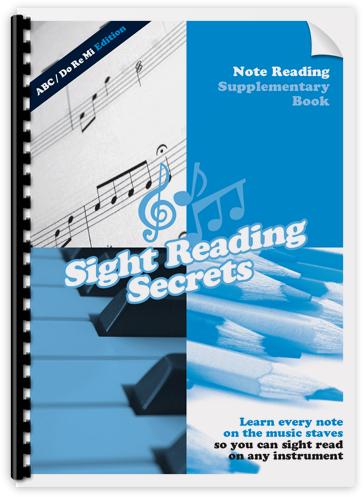
Students will learn to play in C, G, F, A minor and D minor, focusing on one key at a time, including various hand positions for each key. Students will learn which accidentals to expect when playing in A minor and D minor, including examples featuring the raised seventh as well as examples with a melodic minor sound.
To help students play with continuity, there are chapters focusing on Simple Triple time, fingering changes (like second finger moving over the thumb), examples with two-note chords or with an anacrusis.
The last chapter provides opportunities for the student to compose sight reading examples to share with other Grade Nine students!
The book is designed to provide six examples a week for twenty weeks, so students will have daily sight reading examples for the six months leading up to their Grade Nine exam.
